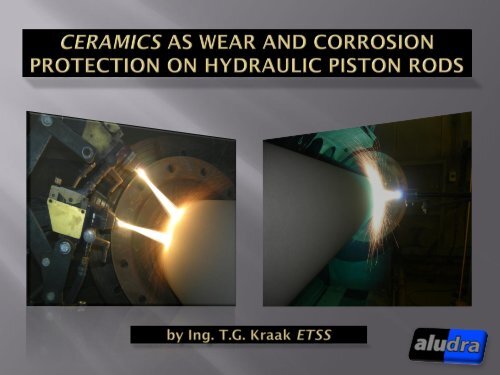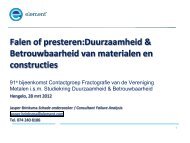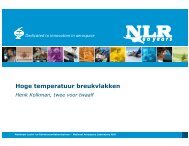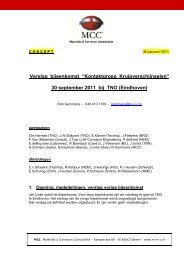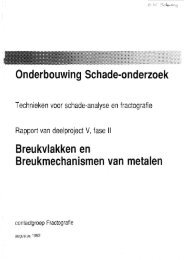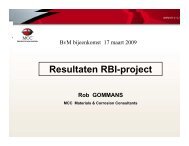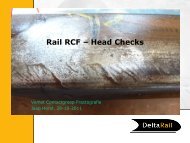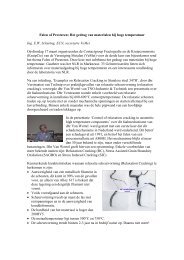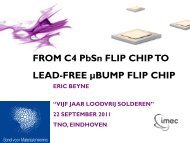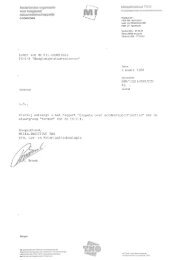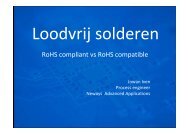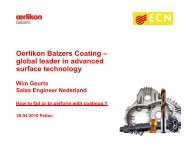alumina/titania chromia/titania - VeMet
alumina/titania chromia/titania - VeMet
alumina/titania chromia/titania - VeMet
- No tags were found...
You also want an ePaper? Increase the reach of your titles
YUMPU automatically turns print PDFs into web optimized ePapers that Google loves.
• Wear in general has a yearly los of capital spending of €120 billion– Corrosion 900 Milliard– Wear 300 Millard• Thermal spraying can attribute not only to:• Reduce these costs, but also• Give added value in terms of increased cycle life time• However to accomplish this one must know the:• Operating conditions,• Fail and wear mechanism• Possibilities and restriction of the available SurfaceTechnologiesto finally:• Come to the right choice of process and coating.
• Hydraulic piston rods are used in several industries s.a.:• Off-shore, civil and industry in general all under differentservice conditions.• They are used to operate the moving parts of:• Docks, sluice doors or marine vessels• In their life time hydraulic piston rods are subjected toextreme environmental conditions s.a.:• Corrosive effects , (attack of salt ,- fresh-, or polluted harbor water),• Chemical resistance to Hydraulic fluids, (pH value, viscosity),• Geographical location, s.a. exposed temp (pole-or tropical conditions) Costal conditions , (wind, sand a.f.)• All above aspects in combination with wear.
Coating Process B.C. T.C. Service ExperienceHard Chromium Electro deposition na Cr 5yrs (still in progress)NiCr CWS na NiCrBoSi >10yrs
• Wear is normally not the issue of failure of hydraulic piston rods,nevertheless wear impact tests are applied to determine the wearresistance of different coatings.• Dry particle abrasion Test ASTM G65• Wet particle abrasion Test ASTM G105• Pin on Drum Abrasion Test ASTM G132• Scratch Resistance Test Applied on System
DRY ABRASION TESTWET PARTICLE ABRASION TESTAbrasive: Dry Sand on rubber rim According to ASTM G65-04Tested: Volume loss• Abrasive: grit+ sea water• According to: ASTM G105-02• Tested: Volume loss
• Wear resistance of a material isdetermined when relative motionis caused between an abrasiveand a contact pin of the testmaterial• According to ASTM G132-96
• Contact force: Actual cylinder pressure• Abrasive: Dry grit• Advantages:• Scratching abrasion of piston rod• Seal guide and scraper behavior• Piston seal behavior• Tests carried out at actual cylinder pressure
Vol loss2001801601401201008060402001000rpm 500rpm 100rpm AverageAl2O3/TiO2 176,2 72,2 78,7 108,9Cr2O3/TiO2 83 25 24 44Wc-Hast 32,8 12,8 10,2 18,6Eaton Hydrowa/ Aludra/ Bundeswehr Hamburg (Prof. Dr. H. Kreye Ing. T.G. Kraak E.T.S.S.) 16-04-2002
Mpa80Bondstrength according to ASTM C-633706050403020100Mpa Mpa Mpa Mpa AverageAl2O3/TiO2 45 51 47 44 45Cr2O3/TiO2 45 44 56 55 47Wc-Hast 70 70 70 70 70Eaton Hydrowa/ Aludra/ SMT (Ing. M. Kiggen, Ing S. Baars , Ing. T.G. Kraak E.T.S.S. 16-04-2002)
To determine the corrosion resistance ofthe as sprayed coatings for the use as afinal coating on hydraulic piston rods thefollowing tests were applied: Salt Spray test according to DIN 50021,ECP test developed by TNO/C-Cube,Chemical resistance to hydraulic fluidMineral oilWater Glycol
• Tested samples Alumina/Titania andChromia/Titania• Cross section after 1000hrs• Rest samples still running>4000hrs• No indication of corrosion of thesubstrate like:• Local spallation or cracking of thecoating• Small and few brown rust spots werevisible at Alumina/Titania sample after1000hrs• Test Chromia/Titania still running>4000hrs. No indication of any failure.Alumina/Titania87/13Chromia/Titania 75/25Carbon steel substrate 300*100*10mm
• Developed to determinepermeability of an inorganiclayer within a few hours,• Non destructive,• On site.• Test is conducted in 2 stepsnamely:Step 1: Estimation of porositylevel,• Potential measurementStep 2: Estimation of thetime-to-time failure.• Galvanostatic test
• Porosity is determined usinga potential measurement for20 hrs.• Exposition in artificialseawater (3% NaCl)• Extremely low OCP of P1(Alumina/Titania) show thatthe coating is permeable inwater.• Concluded with an anodicpolarization curve (adaptedASTM G61 test) used fornoble coatings (relative highpotential) on not noblesubstrate (relative lowpotential)
• Current is impressed in orderto enhance corrosion rate,• Potential is measured duringgalvanostatic polarization,• Galvanostatic level wasobtained from thepolarization curve and achosen factor 10x of thecorrosion current, or thelargest factor possibleavoiding passive layer breakthrough,• At failure of coating potentialwill decrease to substratelevel,• At success of coatingpotential will remain atcoating level.
Coating Code Thickness Process SubstrateHard chromium G1 50um Galvanic C-steelHard chromium G2 60/40um Galvanic C-steelAlumina/Titania P1 300um Plasma C-steelChromia/Titania P2 300um Plasma C-steelNiCr composite H1 200um HP-HVOF C-steelWc-Hastelloy H2 200um HP-HVOF C-steel
Alumina/Titania: Quick decrease of OCP (
Hard chromium (G1) has anOCP of -340mV vs. Ag/AgCl. The rise of the relatively lowpotential (G1) indicates thepresence of tiny pores tothe substrate that fill upwith corrosion products
In the first hour oxygen equilibrium isreached The low potential of the HVOFNiCr composite layer (H1)after 20 hours indicates thepresence of open pores. The potential of the HVOF Wc-Hastelloy matrix (H2) after 20hours is within the boundaries ofNiCr potential. A further decrease to levels lowerthan -0,3VAg.AgCl) would indicatevery low permeability of the coatingor a low layer potential due to othereffects like crevice corrosion;longer term measurements advisable.
Mineral oil and water glycolfluids are used in hydraulicsystems. No degradation of ceramiccoatings was determined usingmineral oil. Degradation in terms ofdissolving Alumina wasobserved using water glycolhydraulic oil.P1 P2 H1Al 2 O 3 /TiO 2 Cr 2 O 3 /TiO 2 NiCrAl 3.8 1.6 1.9 2.8Cr 0.35 5.0 0.71 0.50Ni 6.5 20.5 14 0.13Ti 3.9 2.4 0.3
• About 35 profile parameters are available• Ra, Rq,Rm,Rmax,Pc,Rk,Rvk,Mre etc.• Characterisation of surfaces is often done by Ra;however this is an average value!• Ra does not characterize the surface profile andconditions.• Graphically Ra is the area roughness and it’s averagecut line, with other words the integrate absolute valueover a certain measured length
• Different surface profiles with the same RA value• Different applications in relation with seals.• Fig. 1 Peaks• Fig. 2 Valleys• Fig. 3 Both• Ra is not the right parameter to define topography
• RZ : Sum of highest peak andlowest valley depth within cutoff length. Determines themaximum deviation• Mr: Material contact area in %.The higher the denser thecoating. For lubricationproperties material propertiesare important
• Profile is function of way of machining, (grinding, honing,polishing)• Ceramics low Rz and High Mr,• With lubricant properties Ra not important.,• Pores on the surface is desired,• Orientation of defects downwards,• Mo: High Micro hardness, self lubricating properties, poresfilled with oil increases the lubrication properties anddecreases seal and stuffing box wear,• Define topography in terms of,• No peaks, only valleys (defects downwards orientated)• Rz80% at 1 micron and rpkx
SURFACE TECHNIQUES USEDAT HYDRAULICS• Galvanic layers (NiCr)• Welding (Inconel)• Bendwelding, laser cladding• PVD-CVD-layers (TiN)• Thermal spraying• Plasma (Ceramics)• HVOF (WcCoCrNi -alloys)• Fusable alloys (NiCrBoSi)DEVELOPMENTS FOR IMPROVINGIMPERMEABILITY• Zero porosity coatings By electropolymersation (Bekaert) Sealants (Aludra)• Processing Bondcoat (Inconel, thickness) HVOF-Plasma (Bondcoat-Topcoat) Process (Aludra)• Impermeability improvement as a system(Aludra)
Electro polymerization (monomer > polymer)- Monomer > polymer,- Electrical conductive,- Temporarily filling open pores,- No filling of open pores after finishing thuspermeable.- Not moisture restistant, (>break down ofpolymer chains)- Higher potential than steel• L290 Anoraebe sealer, Hardens thus brittle, No filling of open pores after finishing thus permeable.
• Bondcoat• Thicker (=>150um)• Other types (Inconel 625)• Other Process (HVOF, combination of HVOF+Plasma)• Disadvantages• Increase of costs• Increase of lead time• Parameter optimalization
• Current:Directly effects temperature,and has some effect onvelocity,• Voltageis reliant on total gas volumeand gas conductivity,• Primary Gas:Directly effects velocity andhas some effect on temp.,• Secondary gas:Directly effects temperatureand has some effect onvelocity,• Injection Angle:Effects dwell time and heattransfer• Cooling water:Flow and temperature effectsenergy removed from thesystem. Quality can effecthardware life,• Carrier Gas:Controls the depth ofpenetration into theflame/plasma by the powderstream.
• Advantages:• 100% dense bondcoat,• Corrosion resistant• Micro porous structure ofceramic topcoat remains• No stick slip150um• System can be used in splashzone and under water,• Succeeds in ECP, Salinedroplet test and Salt Spraytest• Testing in final stage
Electrochemical Potential[V] vs. sat. Ag/AgClALUMINA/TITANIA• Composite, Agglomerated & sintered• Bad abrasion resistance,• Can only be used with mineral oil,• Alumina dissolves in water glycol,• Can be used in splash zone whenfrequently goes in and out,• Permeable0-0.1-0.2-0.3Not Permeable Layer-0.4CHROMIA/TITANIA• F&C,• Good Abrasion resistance,• Can be used with mineral oil andwater glycol,• Can be used in splash zone as wellas under water• Impermeable-0.5-0.6Permeable Layer0 1 2 3 4 5Time [h]
•Panama Canal•Saemangeum•Off shore•Civil•Marine•Dredging•Pilling Barge•Dimensions: ø1000*L=20.000mmm
• Under corrosion in the bottom zone of the piston rod which isconstantly in the splash zone /under water and never comesin contact with oil.• Caused by:- Organic sea shells start rottenwhen rod is dry(Increase sulfuric acid concentration)- Bad construction(Water leakage through bottom sealant)- Wrong coating (Alumina/Titania)• Solution:- Chromia/Titania, (Splash zone)- Frequently in/out(Sea shells to be removed)2x44 Ø360*9500mmSaemangeum Project South Korea
• Chalk formation observed of ceramic coating andon stainless steel parts,• No chalk formation on concrete and steel parts,• Caused by:Galvanic corrosion between the nobleintermediate layer and the steel parts of thecylinder.• Solution:- Change in design and material selection. (notpossible)- Isolating the rod from the less noble parts. 8x ø200xL=10.000mmDepth: 40 mtrs under waterGabicikovo project Donau
• Dissolving of Alumina outof Alumina/Titania coating• Caused by:- Attack of the Alumina bywater Glycol hydraulicfluid.(pH>9,5)7x ø190xL=16.000mm3x ø300xL=16.000mm• Solution:Change type of coating intoChromia/Titania
• Coating failure.• Caused by:Mechanical damage bychains.• Solution:Improve OperationalinstructionsØ650xL=14.000mm
• Blistering due to under corrosionof the galvanic hard chromiumlayer• Caused by:- Use of acidic biodegradableconservation oil.• Solution:- Temporarily brushing withTeflon liquid, removing blisterswith UHP water.- Shielding construction- Finally : Remove coating andrenewal.
Mr. Ir. G. van CoolegemMr. J. Kraak bcDr. H. PetersC-CubeFSTH.CStDr. S. ZimmermanMr. Ing. M. KiggenMr W. HerlaarH.CStEatonFST/VTS


